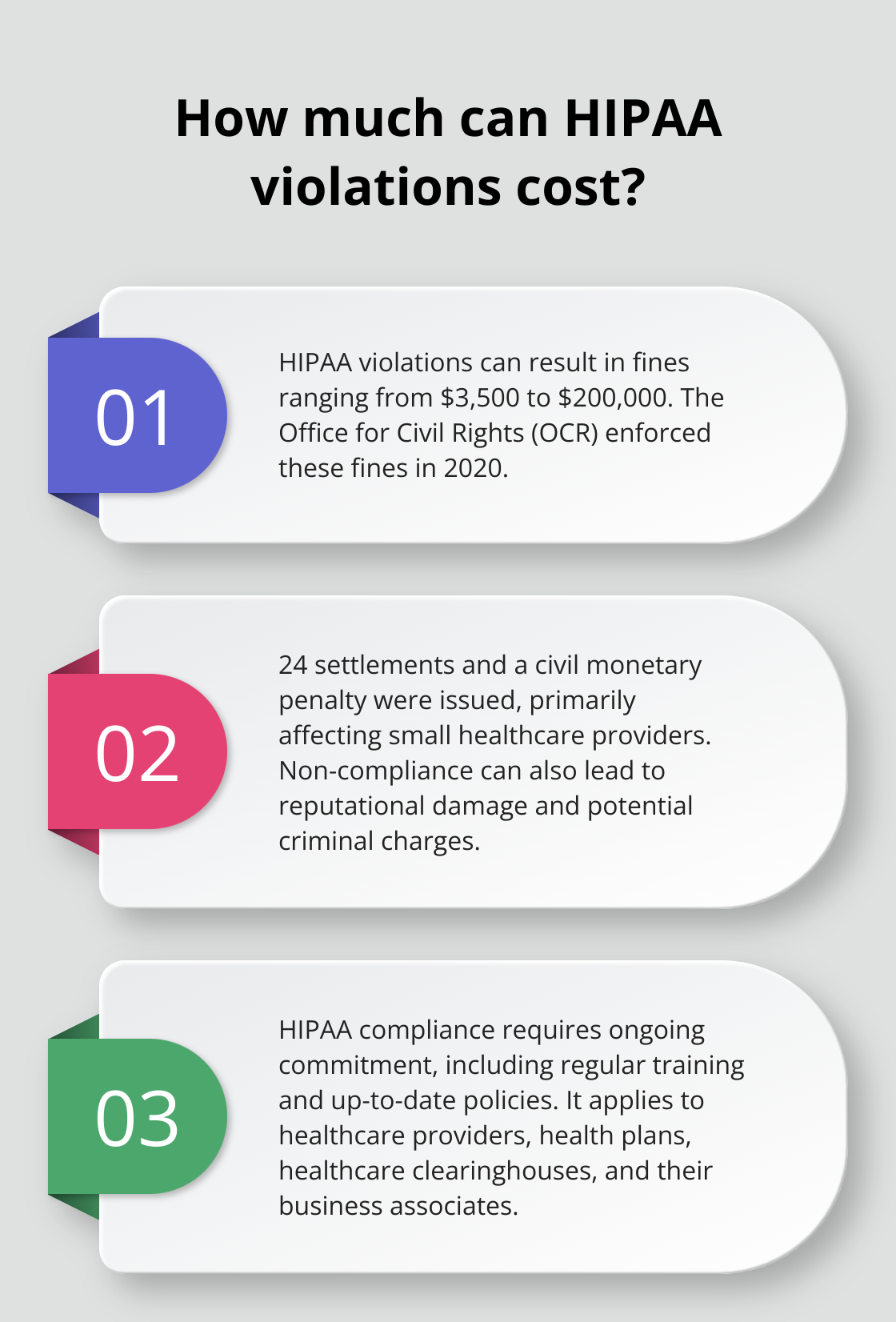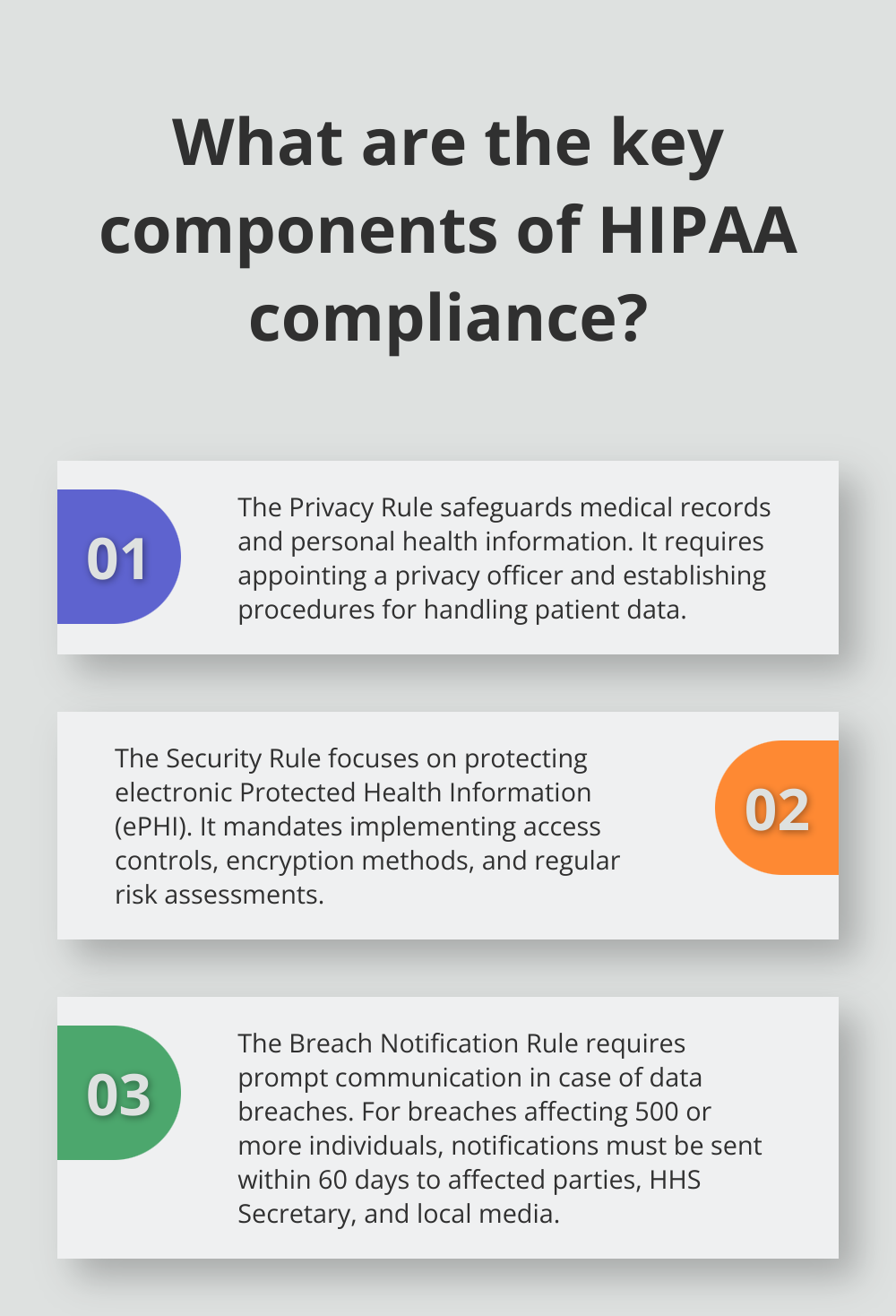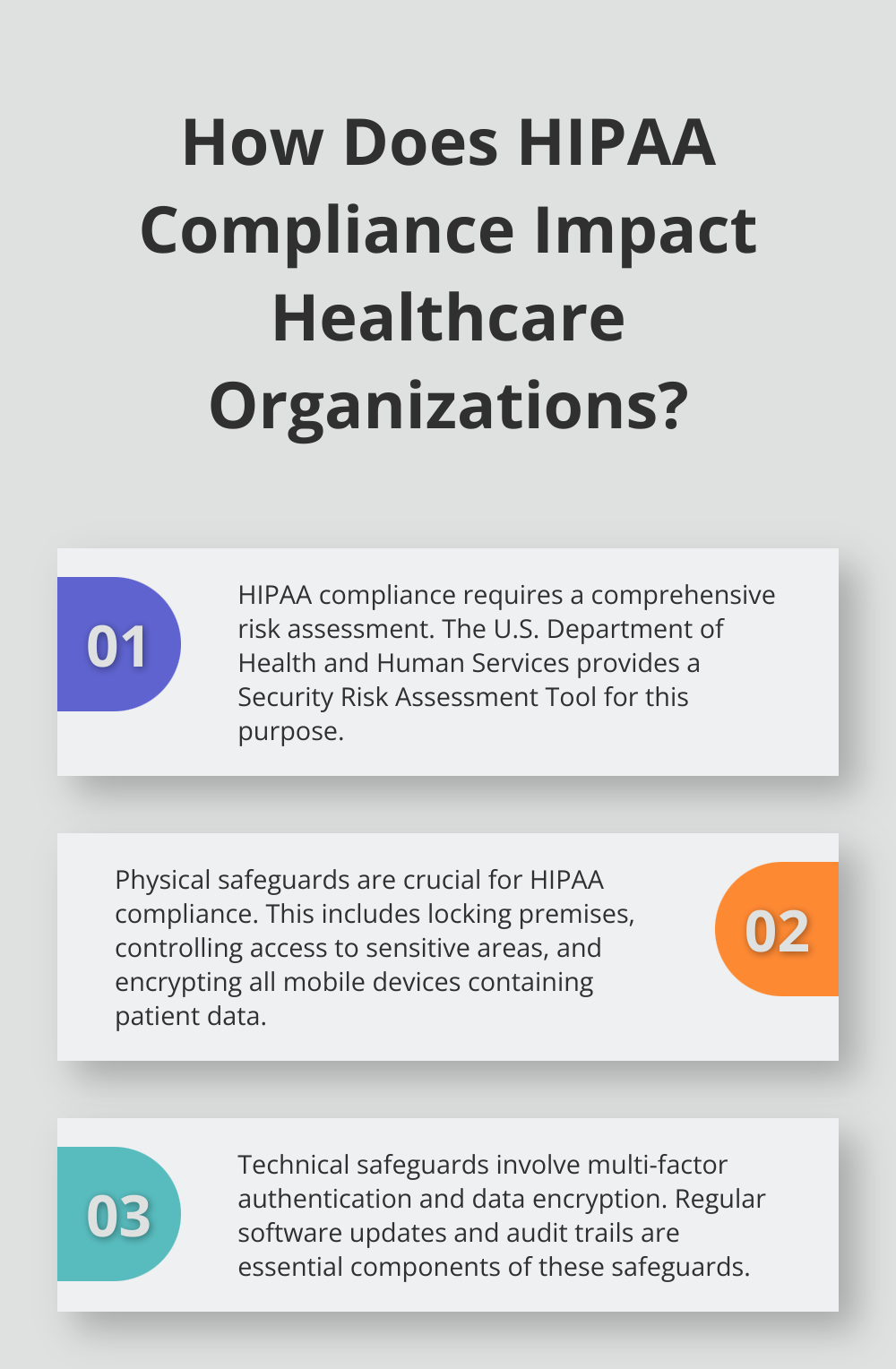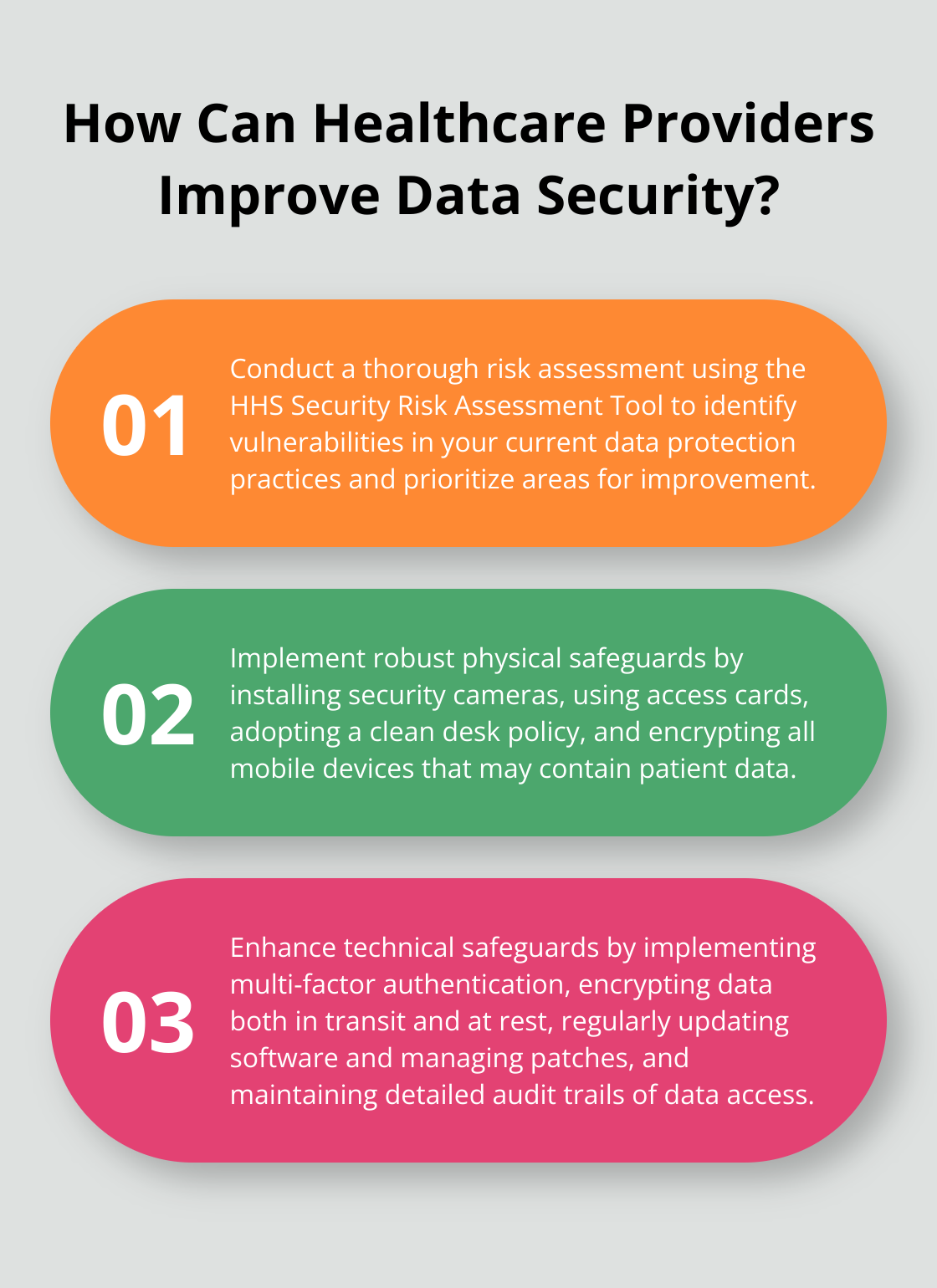HIPAA compliance—yeah, it’s one of those snooze-inducing, yet crucial facets of healthcare data protection—so buckle up. At ScriberJoy, we totally get it. Navigating these labyrinthine regulations? A Herculean task.
Here’s the deal. Our all-in-one HIPAA compliance audit checklist… It’s your roadmap to safeguarding precious patient info while sidestepping those nasty penalties. Whether you’re a healthcare provider, insurer, or just along for the ride as a business associate, this handy guide is your GPS through the winding, often confounding, road to full HIPAA compliance.
What Is HIPAA and Why Does It Matter?
The Essence of HIPAA
So, let’s talk about HIPAA – that’s the Health Insurance Portability and Accountability Act for those keeping track at home. This thing, it’s the cornerstone of patient data protection in the U.S. Since 1996, it’s been the law of the land, laying down the rules for keeping your sensitive health info under wraps. What’s the play here? Make sure your health info stays protected while also letting it flow enough to keep the healthcare machine running smoothly. It’s a legal balancing act, folks.
Core Components of HIPAA
HIPAA is like a jigsaw puzzle made up of several key pieces, all working together to guard your privacy. Here’s the lineup:
- The Privacy Rule: Think of it as the rulebook setting the national standard for shielding your medical records and personal health details.
- The Security Rule: This one’s all about protecting electronic health info when it’s bouncing around between covered entities.
- The Breach Notification Rule: If your unsecured health info gets breached, this rule makes sure somebody picks up the phone and tells you.
- The Enforcement Rule: Picture the disciplinary board – it lays out the whole deal for investigations, penalties, and what happens when HIPAA gets violated.
Who Must Comply?
HIPAA compliance isn’t a “nice to have” – it’s mandatory for a bunch of players in the healthcare game. We’re talking:
- Healthcare providers (doctors, clinics, the whole nine yards)
- Health plans (hey there, insurance companies and government programs)
- Healthcare clearinghouses (those entities turning nonstandard info into something that makes sense)
- Business associates (anyone who handles sensitive health info on behalf of these covered entities)
The Price of Non-Compliance
The OCR – that’s the Office for Civil Rights, everyone’s favorite acronym soup – means business when it comes to HIPAA violations. Back in 2020, they were slapping fines from $3,500 up to a whopping $200,000. A mixed bag of 24 settlements and a civil monetary penalty hit mostly small fry healthcare providers. But, we’re not just talking dollars here. Blow off HIPAA and you risk losing trust, bruising your reputation, and yeah, possibly facing some criminal charges. The takeaway? Don’t mess around; comply.
Ongoing Commitment to Compliance
Nailing HIPAA compliance isn’t a one-and-done. It’s like getting your steps in – you’ve got to keep at it. Regular training, up-to-date policies, strong tech safeguards – these aren’t just good ideas, they’re the price of admission. It’s an evolving dance that keeps you nimble and sharp. Up next, we dive into the nitty-gritty of HIPAA compliance. Buckle up, it’s all about making sure your patient info is locked down tight.

HIPAA Compliance Essentials: Protecting Patient Information
The Privacy Rule: Safeguarding Patient Data
Alright, let’s get into it-The Privacy Rule is basically the bedrock of HIPAA. We’re talking national standards here, set up to shield medical records and personal health info. It’s a playbook for who’s in the game, what needs guarding, and how this sensitive info can be used and shared.

To play ball with the Privacy Rule, you gotta:
- Crown a privacy czar to draft and roll out privacy playbooks
- Send your crew to privacy boot camp
- Have a hotline for folks to raise a stink about privacy faux pas
- Hammer out a penalty box for privacy rule-breakers
The Security Rule: Securing Electronic PHI
Now, while the Privacy Rule has its arms around all PHI, the Security Rule is every bit about the electronic side (ePHI, if you’re into acronyms). This is where you’ll need your admin, physical, and tech game on point to preserve confidentiality, integrity, and security.
Here’s a hit list for the Security Rule:
- Set up lockdown protocols so only the right eyes see ePHI
- Play the encryption-decryption game like a pro to keep ePHI safe on the move
- Scout your weak spots regularly-risk assessments, people
- Keep a digital paper trail to track what’s happening in your ePHI systems
Breach Notification: Swift Communication Matters
Next up-Breach Notification Rule. If there’s a security slip-up with unsecured PHI, notify the folks in charge and-yes, sometimes the media. Speed matters when breaches hit 500 or more.
Here’s who you need to loop in if you’ve got a 500+ breach:
- Inform the affected within 60 days (fast, people)
- Flag the HHS Secretary within that timeframe too
- Drop a heads-up to major media in the area
For breaches hitting less than 500, here’s your to-do list:
- Ping those affected no later than 60 days
- Send an annual report to the HHS Secretary (within 60 days post-calendar year close)
Enforcement: Non-Compliance Consequences
The HHS Office for Civil Rights (OCR) is the enforcement arm that’s not just slapping wrists. We’re talking serious settlements for slip-ups.
To dodge these financial bruisers:
- Run your own compliance checks-get those audits going
- Keep your rulebook up-to-date, always
- Be Johnny-on-the-spot with patient PHI requests
- File away your HIPAA compliance tracks with care
Grasping these HIPAA basics? It’s game time. Up next-a robust checklist. We’ll arm you with a detailed list to outmaneuver those compliance hurdles and secure top-tier protection for patient data.
Your HIPAA Compliance Action Plan
Assess Your Current State
Alright folks, time to embark on the HIPAA compliance journey. Step one-it all starts with a hearty risk assessment. What does this mean? Well, basically you’re doing a deep dive into what you’ve got going on right now. The triumphant U.S. Department of Health and Human Services hands you a Security Risk Assessment Tool. Use it. Seriously. It’ll spotlight where your security is shaky, helping you triage those priorities pronto.
Implement Physical Safeguards
Let’s talk physical security-it’s the frontline superhero of defense. Lock up your premises, hide those sensitive docs, and control who wanders into areas loaded with patient info. Think security cameras and access cards-invioable sentinels, keeping tabs and banning casual strolls into restricted zones. Adopt a clean desk policy (think of it as Marie Kondo-ing confidentiality). And those mobile devices everyone’s glued to? Encrypt every laptop, tablet, and smartphone that might cradle patient data-because, trust me, they’re a hacker’s favorite snack.
Enhance Technical Safeguards
Technical safeguards-oh boy, they’re more than a souped-up antivirus package. Let’s add some layers. Enter multi-factor authentication-a system nobody’s breaking into without jumping through hoops. Data encryption is your non-negotiable buddy here; we’re talking in transit, at rest, all of it. Regular software updates and patch management? They’re your shield against sneaky vulnerabilities. And don’t dare overlook audit trails-because you need a hawk’s eye to track who accessed what and when.
Educate Your Team
Ah, your team-the unforeseen VIPs in HIPAA compliance. The game plan is thorough training, not just annual boring PowerPoints. We’re talking real-world scenarios and interactive sessions that’ll stick-it’ll make data protection feel gripping, almost like a Netflix documentary. Empower every team member to spot and shout about potential breaches. Knowledge is your secret weapon here.
Update Policies and Procedures
Folks, HIPAA compliance isn’t a one-time checklist; it’s a 24/7 mission. Regularly review and renew your documentation to match the pace of shifting regulations and emerging threats. This means privacy notices, consent forms, and internal protocols-all of it. Make these docs accessible and ensure that updates are served up with clarity. Not a whisper of change passes without every staff member in the loop.

Final Thoughts
HIPAA compliance – it’s not just a checklist, folks, it’s about safeguarding patient trust and your organization’s reputation. As the rulebook evolves and new threats pop up… healthcare providers, buckle up. Regular check-ups on your processes, training your team, constant policy tweaks-this isn’t just optional, it’s the best way to dodge those nasty breaches and violations.

Keeping HIPAA compliance tight boosts your standing, wins patient confidence, and makes operations smoother with sharp data management. Healthcare folks, dive deep into risk assessments, give your policies a health check, and get your staff up to speed. Laying down this groundwork? It’s your armor for HIPAA compliance. It’s not just about the info – it’s the trust that builds the whole healthcare gig.
And hey, for those looking to cut through the paperwork mess without cutting corners on HIPAA compliance, ScribeJoy is your copilot. This AI-powered sidekick doesn’t just talk the talk; it merges smart tech with human know-how to churn out medical documents with the precision of a surgeon’s scalpel – over 99% accurate. All while sticking to those ironclad HIPAA rules. Bottom line? Shielding patient info is key to earning trust and ticking the success box for healthcare outfits.

Leave a Reply
You must be logged in to post a comment.